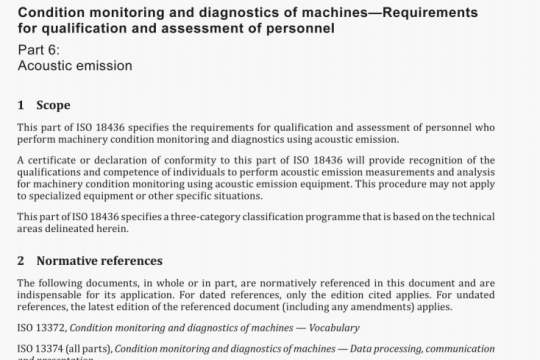ISO TR 3313:2018 pdf free
ISO TR 3313:2018 pdf free.Measurement of fluid flow in closed conduits – Guidelines on the effects of flow pulsations on f1 ow-measurement instruments
A vortex flowmeter is subject to very large pulsation errors when the vortex-shedding process locks in to the flow pulsation. There is a danger of this happening when the pulsation frequency is near the vortex- shedding frequency. At a sufficiently low amplitude, locking-in does not occur and flow-metering errors due to pulsation are negligible. This threshold amplitude, however, is only about 3 % of the mean velocity and is comparable to the velocity turbulence amplitude. The consequences of not detecting the pulsation or erroneously assuming the amplitude is below the threshold can be very serious. This issue is discussed further in 6.3.
Pulsation occurs commonly in industrial pipe flows. It might be generated by rotary or reciprocating positive displacement engines, compressors, blowers and pumps. Rotodynamic machines might also induce small pulsation at blade passing frequencies. Pulsation can also be produced by positive-displacement flowmeters. Vibration, particularly at resonance, of pipe runs and flow control equipment is also a potential source of flow pulsation, as are periodic actions of flow controllers, e.g. valve “hunting” and governor oscillations. Pulsation might also be generated by flow separation within pipe fittings, valves, or rotary machines (e.g. compressor surge).
In industrial flows, there is often no obvious indication of the presence of pulsation, and the associated errors, because of the slow-response times and heavy damping of the pressure and flow instrumentation commonly used. Whenever factors such as those indicated in 5.3 are present, there is the possibility of flow pulsation occurring. It should also be appreciated that pulsation can travel upstream as well as downstream and thus possible pulsation sources could be on either side of the flowmeter installation.However, amplitudes might be small and, depending on the distance from pulsation source to flowmeter, might be attenuated by compressibility effects (in both liquids and gases) to undetectable levels at the flowmeter location. Pulsation frequencies range from fractions of a hertz to a few hundred hertz; pulsation amplitudes relative to mean flow vary from a few percent to 100 % or larger. At low percentage amplitudes the question arises of discrimination between pulsation and turbulence.ISO TR 3313 pdf free download.




